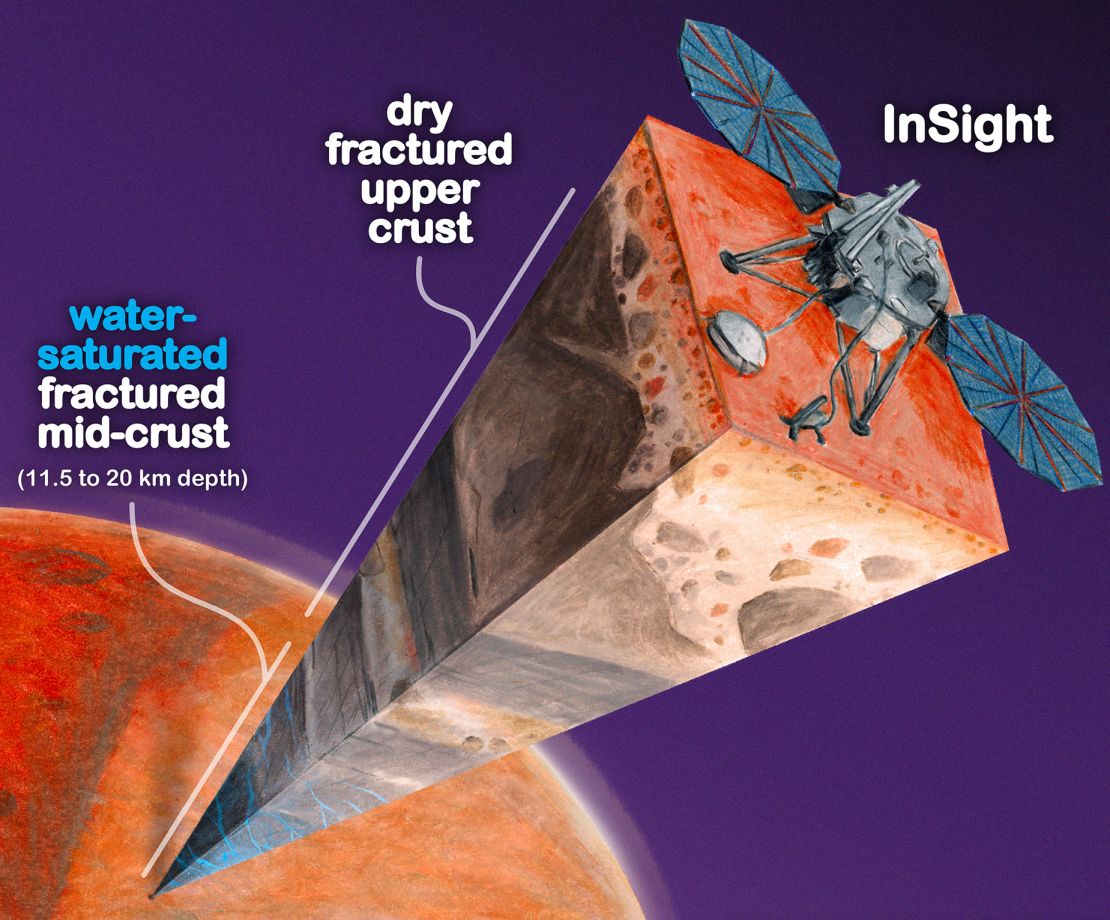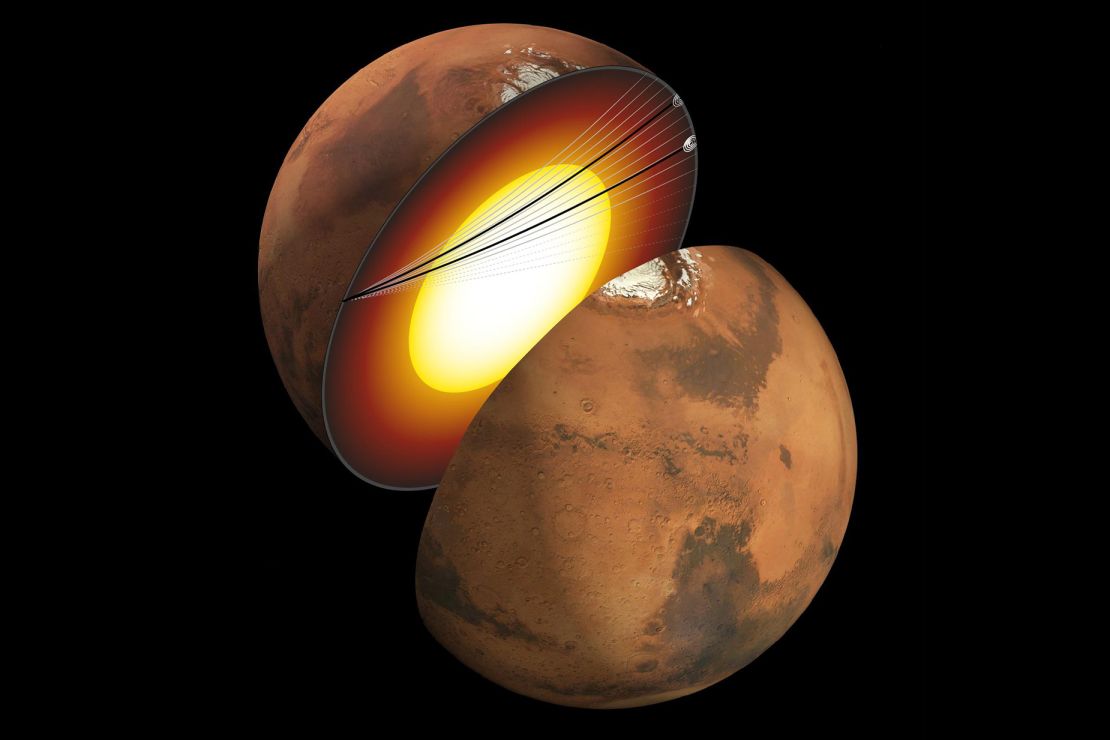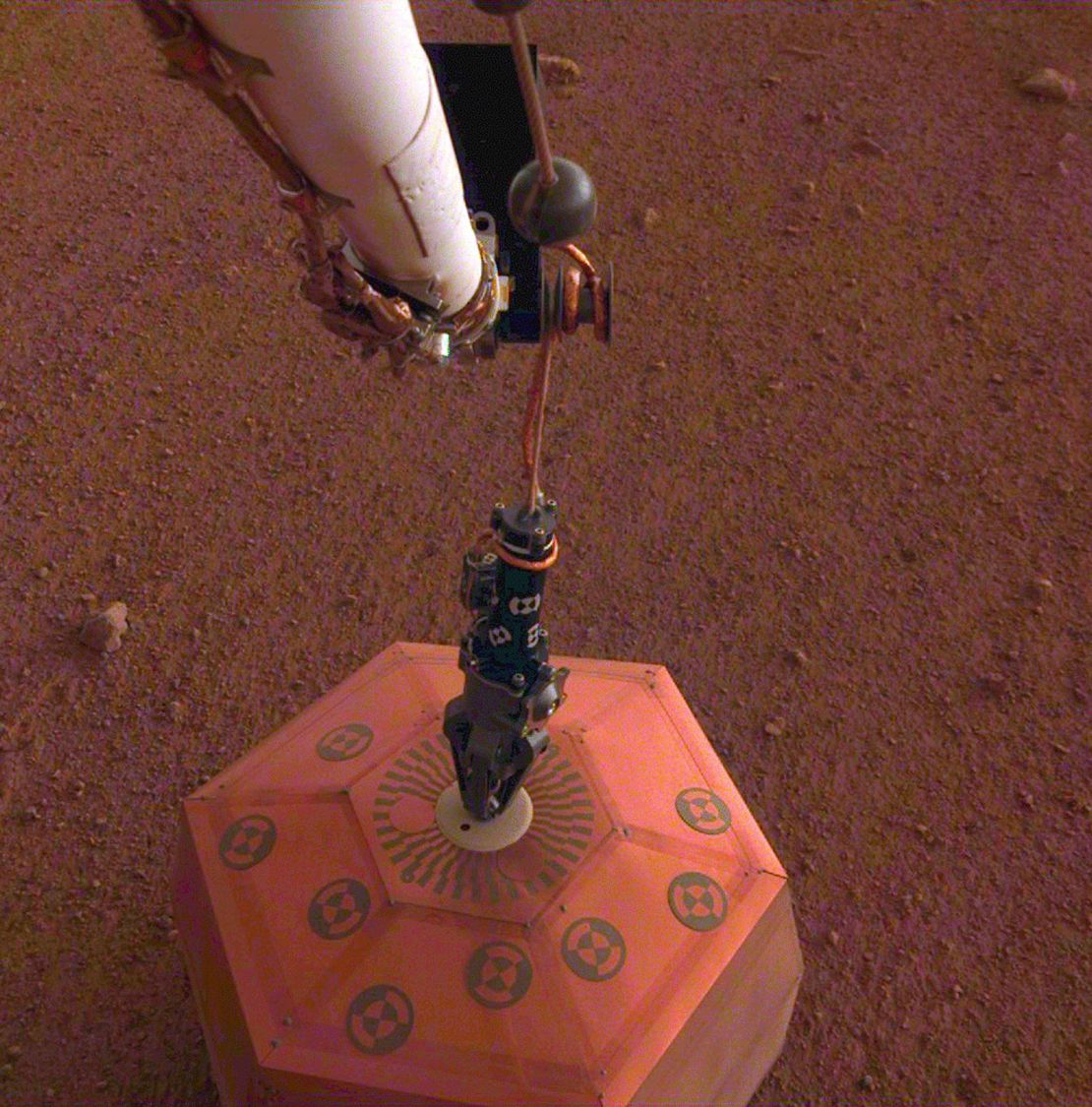Sign up for CNN’s Wonder Theory science newsletter. Explore the universe with news about fascinating discoveries, scientific breakthroughs and more.
CNN
—
Data from a retired NASA mission has revealed evidence of an underground reservoir of water deep beneath the surface of Mars, according to new research.
A team of scientists estimates that there may be enough water trapped in small cracks and holes in rocks in the middle of the Martian surface to fill oceans on the planet’s surface. The study found that groundwater covers the entire surface of Mars up to 1 mile (1.6 kilometers) deep.
The data comes from NASA’s Inside lander, which used a seismometer to study the Martian interior from 2018 to 2022.
Future astronauts exploring Mars will face a whole host of challenges if they try to access water, as it lies between 7 and 12 miles (11.5 and 20 kilometers) beneath the surface, according to a study published Monday in the journal Astrophysics. Proceedings of the National Academy of Sciences.
But the discovery reveals new details about the geological history of Mars — and suggests a new place to look for life on the Red Planet if water could ever be accessed.

“Understanding the Martian water cycle is critical to understanding the evolution of the climate, surface and interior,” said lead study author Vashon Wright, a geophysicist and assistant professor at the University of California, San Diego’s Scripps Institution of Oceanography. “A useful starting point is to find out where the water is and how much there is.”
Mars may have been a warmer, wetter place billions of years ago, based on evidence of ancient lakes, river channels, deltas and rocks studied by other NASA missions and replaced by water monitored by orbiters. But the Red Planet lost its atmosphere 3 billion years ago, effectively ending the wet period on Mars.
Scientists still aren’t sure why Mars lost its atmosphere, and a lot of work has been done to learn about the history of the planet’s water, where it went, and what created the conditions for water to ever survive on Mars. Although water is trapped as ice in the planet’s polar ice caps, researchers don’t believe it accounts for all of the planet’s “lost” water.
Existing theories offer a few possible scenarios for what happened to Martian water after it lost its atmosphere: some think it turned into ice or was lost to space, while others say it was incorporated into minerals beneath the planet’s surface or trickled into deep water.
New findings suggest that water on Mars filtered into the Martian crust.
InSight is a compact, stationary lander for interior exploration using seismic surveys, geomorphology and thermal transport. But it collected unprecedented data on the thickness of the Red Planet’s crust and the temperature of its crust, as well as the depth and composition of the core and atmosphere. The lander’s seismometer detects the first earthquakes on another planet.
While earthquakes occur when tectonic plates shift, move, and grind against each other, Mars is like a giant plate with faults and fractures as it shrinks and cools over time. As Mars’ crust expands, it cracks, and InSight’s seismometer has been able to detect more than 1,300 marque earthquakes from hundreds and thousands of miles away.
Scientists studying InSight’s data were able to study the speed of Martian earthquakes as they traveled through Mars, which could serve as an indicator of what materials lie beneath the Martian surface.
The speed of seismic waves depends on what the rock is made of, where the cracks are and what fills those cracks, Wright said.
The team used this data and fed it into a mathematical model of rock physics, which is used to map underground oil fields and aquifers on Earth.
The results show that InSight’s data match a deep layer of lava or igneous rock filled with liquid water.

“Establishing the existence of a large reservoir of liquid water provides some windows into what the climate was like or could be like,” Michael Manga, a professor of Earth and planetary sciences at the University of California, Berkeley, said in a statement.
“Water is essential for life as we know it. I don’t know why (the underground reservoir) is not a habitable environment,” Manga added. “That’s certainly true on Earth — deep, deep tunnels support life, the ocean floor supports life. We don’t have any evidence of life on Mars, but at least, in principle, we’ve identified a place that could sustain life.
If the Martian crust was uniform across the planet, the authors wrote in the study, there could be more water within the mid-crustal zone than “the blocks proposed to fill ancient Martian oceans.”
Rocks help capture information about a planet’s history, Wright said, and understanding a planet’s water cycle could help researchers unlock the evolution of Mars.
Although analysis of the data cannot reveal any information about past or present life on Mars, the wet Martian crust could be host to microbes from Earth’s deep subsurface. He said.
But drilling even a half-mile (1 kilometer) or so deep hole on Earth is a challenge that requires energy and infrastructure, so drilling to such depths would require bringing a lot of resources to Mars, Wright said.

Because that part of the crust is cold, the team was surprised to find no evidence suggesting a layer of frozen groundwater beneath the interior. Researchers are still trying to determine why there is no frozen groundwater at shallow depths above the mid-crust.
The findings add a new piece to the Martian water puzzle.
The idea that liquid water might exist beneath the surface of Mars has been around for decades, but this is the first time actual data from Mars has confirmed such a speculation, said Alberto Farron, a visiting planetary scientist and astronomer at the department. Astronomy at Cornell University. Fearon was not involved in the study.
The water is “a kind of deep underground mud,” he said.
“These new results demonstrate that liquid water exists on the Martian surface today, not in the form of discrete and isolated lakes, but as liquid water-saturated sediments or aquifers,” Farren said. “On Earth, the subsurface biosphere is truly vast, containing the majority of prokaryotic diversity and biomass on our planet. Some studies even trace the origins of life on Earth precisely deep underground. So, the astronomical implications of finally confirming the existence of liquid water habitats kilometers beneath the surface of Mars are truly amazing.” ”

The result is “the kind of thing I hoped we’d get out of InSight,” said Bruce Bannert, principal investigator of the InSight mission.
“I was hoping that when we actually looked at the details of the Martian interior related to questions of geology, questions about habitability on Mars, questions about evolution, there would be enough data to do these kinds of studies on Mars,” he said.
Banert, who was not involved in the study, said that while the interpretation of the data presented in the paper is strongly supported by good arguments, it is still somewhat speculative and that there is always another way to interpret any given set. data.
“I was very impressed by the way Wright et al brought mineral physics concepts to interpret the seismic data,” Banert said.
Both Banerd and Wright expressed interest in the future ability to send more seismic measurements to Mars and other planets and moons in our solar system. While InSight’s seismometer will collect important data, spreading them around Mars will reveal variations in the planet’s interior and provide a larger window into its varied and complex history, Bannert said.
“Just as groundwater on Earth is connected to the surface by rivers and lakes, this was certainly the case on early Mars,” Wright said. “The groundwater we see is a record of that past.”
